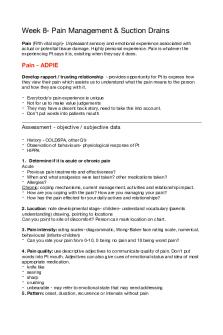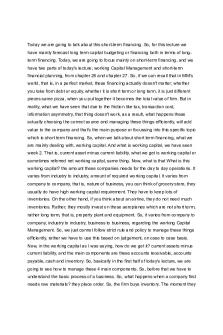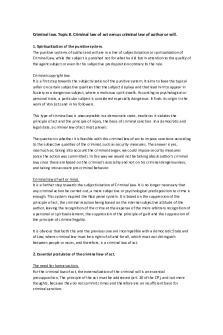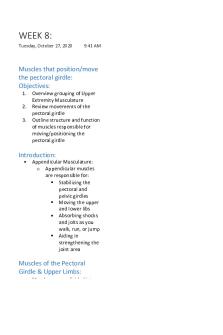EB MB [075-094] - Lecture notes 8 PDF
![EB MB [075-094] - Lecture notes 8](https://pdfedu.com/img/crop/300x450/eq532kw32pzr.jpg)
| Title | EB MB [075-094] - Lecture notes 8 |
|---|---|
| Course | English for Business |
| Institution | Singapore Institute of Management |
| Pages | 20 |
| File Size | 1.1 MB |
| File Type | |
| Total Downloads | 854 |
| Total Views | 933 |
Summary
Writing Essays & CitationsOBJECTIVESBy the end of the lecture, you should be able to: Know the elements of a good introduction Know how to structure and develop body paragraphs Know how to end a piece of writing with an effective conclusion Basic introduction to referencing and citation (APA for...
Description
Session
7
Writing Essays & Citations
OBJECTIVES By the end of the lecture, you should be able to: • Know the elements of a good introduction • Know how to structure and develop body paragraphs • Know how to end a piece of writing with an effective conclusion • Basic introduction to referencing and citation (APA format)
1.0
Parts of an Essay An essay has three main parts: • An introduction • Several supporting paragraphs (body) • A conclusion Note that a typical essay contains five paragraphs. However, the number of paragraphs may vary according to the length of the essay and its purpose. Read the sample essay below: The Hazards of Moviegoing By John Langan From College Writing Skills with Readings
Introductory I am a movie fanatic. When friends want to know what picture won the Oscar in 1980 or who played the police chief in Jaws, they ask paragraph me. My friends, though, have stopped asking me if I want to go out (Thesis) to the movies. The problems in getting to the theater, the theater itself, and the behavior of some patrons are all reasons why I often wait for a movie to show up on TV.
English for Business
Page 75
First supporting paragraph
First of all, just getting to the theater presents difficulties. Leaving a home equipped with a TV and a video recorder isn't an attractive idea on a humid, cold, or rainy night. Even if the weather cooperates, there is still a thirty-minute drive to the theater down a congested highway, followed by the hassle of looking for a parking space. And then there are the lines. After hooking yourself to the end of a human chain, you worry about whether there will be enough tickets, whether you will get seats together, and whether many people will sneak into the line ahead of you.
Second supporting paragraph
Once you have made it to the box office and gotten your tickets, you are confronted with the problems of the theater itself. If you are in one of the run-down older theaters, you must adjust to the musty smell of seldom-cleaned carpets. Escaped springs lurk in the faded plush or cracked leather seats, and half the seats you sit in seem loose or tilted so that you sit at a strange angle. The newer twin and quad theaters offer their own problems. Sitting in an area only onequarter the size of a regular theater, moviegoers often have to put up with the sound of the movie next door. This is especially jarring when the other movie involves racing cars or a karate war and you are trying to enjoy a quiet love story. And whether the theater is old or new, it will have floors that seem to be coated with rubber cement. By the end of a movie, shoes almost have to be pried off the floor because they have become sealed to a deadly compound of spilled soda, hardening bubble gum, and crushed Ju-Jubes.
Third supporting paragraph
Some of the patrons are even more of a problem than the theater itself. Little kids race up and down the aisles, usually in giggling packs. Teenagers try to impress their friends by talking back to the screen, whistling, and making what they consider to be hilarious noises. Adults act as if they were at home in their own living rooms and comment loudly on the ages of the stars or why movies aren't as good anymore. And people of all ages crinkle candy wrappers, stick gum on their seats, and drop popcorn tubs or cups of crushed ice and soda on the floor. They also cough and burp, squirm endlessly in their seats, file out for repeated trips to the rest rooms or concession stand, and elbow you out of the armrest on either side of your seat.
Concluding paragraph
After arriving home from the movies one night, I decided that I was not going to be a moviegoer anymore. I was tired of the problems involved in getting to the movies and dealing with the theater itself and some of the patrons. The next day I arranged to have cable TV service installed in my home. I may now see movies a bit later than other people, but I'll be more relaxed watching box office hits in the comfort of my own living room.
English for Business
Page 76
Activity 1 Complete the outline of a five-paragraph essay based on the above passage: Outline for a Five-Paragraph Essay Title: ____________________ I.
Introduction A. Introductory statement B. Thesis statement: ____________________
II.
Body A. First Supporting Idea (Topic Sentence): ___________________________________ 1. ___________________________________ 2. ___________________________________ 3. ___________________________________
III.
B.
Second Supporting Idea (Topic Sentence): ___________________________________ 1. ___________________________________ 2. ___________________________________ 3. ___________________________________
C.
Third Supporting Idea (Topic Sentence): ___________________________________ 1. ___________________________________ 2. ___________________________________ 3. ___________________________________
Conclusion A. Closing statement B. Restate thesis: ____________________
The five-paragraph essay is a basic format for essay writing. As business students, we need to learn to write in the most comprehensive way and learn to write to the point. Look at the pointers below on what to consider when writing a Five-paragraph essay.
English for Business
Page 77
2.0
General Structure of a Five-Paragraph Essay
The five-paragraph essay follows a defined format. The first paragraph introduces us to the thesis of the essay and directs us to the three main supporting subtopics. The second through fourth paragraphs are all similar in format. They individually restate the subtopics, and are developed by giving supporting information. The fifth and last paragraph restates the main thesis idea and reminds the reader of the three main supporting ideas that were developed. All of these paragraphs are important. Introductory Paragraph Attention grabber Thesis statement mentioning the 3 subtopics Transition First Supporting Paragraph Restate Subtopic One 1. First Supporting Detail or Example 2. Second Supporting Detail or Example 3. Third Supporting Detail or Example Transition Second Supporting Paragraph Restate Subtopic Two 1. First Supporting Detail or Example 2. Second Supporting Detail or Example 3. Third Supporting Detail or Example
Transition Third Supporting Paragraph Restate Subtopic Three 1. First Supporting Detail or Example 2. Second Supporting Detail or Example 3. Third Supporting Detail or Example
English for Business
Page 78
2.1
The Introductory Paragraph
The introductory paragraph is the place where the writer introduces the reader to the topic. The introductory paragraph introduces us to the thesis of the essay and directs us to the three main supporting subtopics It is important to make this a clear and limited statement. This is where the writer grabs the reader's attention. Because of its purpose, the attention grabber is often the first few sentences of the paragraph. It is followed by three subtopics that develop the thesis. Between this paragraph and all paragraphs of the essay, there needs to be some kind of a transition word, phrase, or sentence. Introductions, also called leads are critical to the success of the essay. Effective introductions do two things immediately. • •
Focus the reader’s attention on the subject Provoke the reader’s curiosity or interest
2.1.1 Thesis Statement Effective essays centre on a thesis or main point that a writer wishes to express. This central idea is usually presented as a thesis statement in the introduction. A good thesis statement tells the audience the topic of discussion and presents the writer’s attitude, opinion, idea or point about that topic. For example, look at the following thesis statement: Owning a pet has several important benefits. In this thesis statement, the topic is owning a pet; the writer’s main point of view is that owning a pet has several important benefits. Another alternative is a more specific thesis statement – Owning a pet has several benefits such as providing companionship, encouraging the owners to physical exercise, and promoting a sense of responsibility
English for Business
Page 79
Thesis Statement
Is a single, clear, sharply-focused sentence Is the topic sentence for the whole essay Identifies the subject of your essay Is focused enough so you can cover the topic thoroughly Can be "open" or "closed" An effective thesis statement is one which – tells the audience the topic – presents your attitude, opinion or idea about a topic
Open (Broad & general) Nuclear energy is too dangerous to be used as a source of electrical energy. Closed (Specific & detailed) Nuclear energy is too dangerous to be used as a source of electrical energy because of its potential hazard for people in the vicinity of the power plant and its detrimental effects on the environment.
2.1.2 Strategies for Introductions •
The importance / benefits for the readers ‘What’s in it for me?’ That is the question almost all readers will ask themselves in the first minute or two. If they can immediately identify the benefit(s) / importance of the topic, they have vested interest to continue and find out more.
•
Emphasis on the problem Bad news is another aspect that readers like to gravitate towards. It is no surprise that the majority of news broadcasts focuses on the crisis and problems. Likewise, highlighting the seriousness / magnitude of the issue in the introduction will likely attract the readers’ attention and encourage them to read on.
English for Business
Page 80
•
Quotation This is a common strategy used for academic writings. The quotation can come from an expert on the subject you are exploring, an ordinary person with related experience or any number of well-known sources (e.g., literature, religious or philosophical writings) or well-known people (e.g., politicians, scientists, management gurus, educators). The quotation helps focus the reader on your subject. Even music lyrics, poems etc. may provide an interesting introduction to your subject. Example: Former U.S. President J.F. Kennedy once said: “It is not what the country can do for you, but what you can do for your country.” Most of the people around us are always complaining about the problems in their community and the country in general. However, they do little to help or to provide alternatives for those problems. If you want to help, there are many things you could do! Cleaning your neighborhood, participating in civil organizations, and acting as a role model are just some examples of how you can help your country.
•
Illustration An example illustrating your topic may give the reader a sense of ‘being there.’ Allowing the audience to sense the situation or issue (showing rather than telling) may be essential in drawing them to the points you will explore or argue. Another common way to start an illustration would be ‘Imagine . . . ‘ E.g. of using an illustration He was a fairly large man, who always appeared in dark suits that made his cocoa brown skin seem even darker. He had a kind face with a high forehead and sensitive eyes. While he looked like a man with a great capacity for love and understanding, he also projected an image of strength with his sturdy body and determined walk. His voice could be soft and soothing, or it could be so powerful that it could rouse a thousand people to action. This man was Martin Luther King, and no educated person in America should be ignorant of his contributions to our nation.
English for Business
Page 81
•
Anecdote This is a common strategy used by newspaper and magazine writers. Providing an interesting but brief story is a good way to raise interest in your topic. If you are the main character in the story, you might also be showing your reader why this topic is important to you. Your relationship to the topic becomes immediately clear. E.g. of using an anecdote Last June while working in a construction firm, I met a lot of guys who were going to university. They knew I would be attending UniSIM in July, so when we take a break, they would always try to impress me by telling me how hard university was. They spoke of impossibly difficult tests, hours upon hours of homework, and stern professors who demanded nothing but the best from their students. I must admit that they had me scared, but now that I have been at UniSIM for a year, I know that students can do well in their studies if they discipline themselves to study regularly, take good class notes, and miss class only for illness and emergencies.
•
Historical Background A topic may need a brief background in order for the audience to understand the rationale of your point of view or why a problem occurred. E.g. Sentosa - first it was a former fishing village, then a British military base, and by 1972, Sentosa was transformed into an idyllic island resort for the enjoyment and recreation of everyone. Situated half a km south of Singapore, Sentosa (meaning peace and tranquility) is accessible within minutes by cable car, ferry or via a 710-metre road link.
•
Current Affairs If your topic is on a current or controversial subject, you may find a newspaper article that can serve as an introduction to your discussion. This appeals to the readers because it implies relevance and therefore, immediate interest.
English for Business
Page 82
•
Statistics Facts and figures may surprise your reader and gain interest in the topic. Numbers appeal to the readers’ minds / logic. Having said that, effective writers would pick one or two attention-getting figures, rather than overwhelming the readers with too much data.
•
Questions Asking a question or a series of questions in the introduction is one way to draw the reader into the main text, where you will answer those questions. Example: Did you ever see a soft drink commercial that talked about soft drinks? Well, some might tell us that the drink being advertised will quench our thirst, or that a particular diet pop has only so many calories or contains no caffeine. But most of the time the emphasis in soft drink ads is on the people--surfers on the beach, slim sexy women doing aerobic dances, carloads of preppies waving pop cans, or break-dancers hip-hopping down a city street. These ads are not selling pop; they are selling images. Most soft drink companies want us to believe that if we drink their product we will be part of a happy crowd. NOTE: One or two thought-provoking questions will do. Any more than 2 questions, and the readers will be asking, ‘Where are all these going?’
•
Controversial Statement Saying something shocking is another way of getting readers into your discussion. You have to use good judgement as to the degree of shock value, though. You do not want to offend the audience right from the start because you don’t get a second chance to form a good first impression. The idea is to gain attention, not lose it. E.g. Only about a third of each class that enters this course each year ever graduate. It is not that these students are not intelligent, and the reasons twothirds drop out are many. Some merely get homesick, others transfer to different courses, and still others leave for personal or economic factors. Yet a large number of students do leave for academic reasons, and most of these students never graduate because they do not realize the time and dedication to study that success in university requires.
English for Business
Page 83
Activity 2 Write one Introductory paragraph using any of the Strategies of Introduction found above and end each of the paragraphs with the thesis statement, ““Public Transportation can solve our city’s pressing problem”.
3.0
Body (made up of several Supporting Paragraphs)
Next, the body of the essay contains paragraphs two through four. They are all similarly constructed. Their topic sentences are restatements, often in original form, of the three supporting ideas presented in the first paragraph. The subtopic of each of the body paragraphs is again supported by three or more supporting sentences. These cement, in the reader's mind, the relevancy and relationship of each of the subtopics to the thesis statement. In the earlier exercise, you have written 2 introductory paragraphs that ended with the following Thesis Statement: “Public Transportation can solve our city’s pressing problem”. Assume that the following are the reasons for the above thesis statement mentioned in your introductory paragraph Reasons –
a) Reduces traffic congestion b) Reduces pollution c) Any other reason you can think of?
English for Business
Page 84
Step 1 – Examine your first reason; “Reduces traffic congestion” Step 2 – Explain what you mean (How can traffic congestion can be reduced?) Use examples to back up you ideas. You might draw examples from other countries. Step 3 – Put your ideas together in step two to create a paragraph. Keep in mind that there should be only one main topic area within a paragraph. Step 4 – Repeat steps 1-3 for the second and third reasons.
Activity 3 Now, write the body paragraphs using the step given above. You can use the reasons given above or any other reasons you can think of.
4.0
Conclusion
Finally, the fifth paragraph is the summary paragraph. It is important to restate the thesis and three supporting ideas in an original and powerful manner as this is the last chance the writer has to convince the reader of the validity of the information presented. The reader expects the conclusion to do some or all of the following • • • •
rephrase the thesis statement summarize the supporting ideas give your opinion, if you haven't given it already look to the future (say what will happen if the situation continues or changes)
The reader DOES NOT expect new information in the conclusion. Never add a new idea just because you have thought of it at the end! You must do all of this in just three or four sentences The conclusion is very similar to the introduction. However, you should avoid repeating the same words. This is why a few minutes spent at the start of the exam writing down synonyms (words with the same meaning) and related words is very helpful.
English for Business
Page 85
4.1
Strategies for Conclusion •
Make a comment on (but do not repeat) the thesis statement Example: Watching movies at home, definitely, has several advantages over going to the theater. This way you don’t spend so much money, you can use your time more effectively, and you can enjoy the comfort of your house. There’s nothing better than staying at home on a rainy day while enjoying a good movie on your TV screen.
•
Remind the audience what action you want them to take
•
Use a question to keep the audience thinking Example: You can help your country by contributing in many ways. Are you going to sit around waiting for the government to do everything? What will happen in the future, when the government can no longer sustain your needs? What will happen to your children and their future generations? Do they have to pay for your laziness? Stand up and do something!
•
Suggest a solution, make a recommendation or prediction Example: Nowadays, women are being more exploited than ever on TV commercials and other propaganda. These commercials are ...
Similar Free PDFs
![EB MB [075-094] - Lecture notes 8](https://pdfedu.com/img/crop/172x258/eq532kw32pzr.jpg)
EB MB [075-094] - Lecture notes 8
- 20 Pages

EB MB lesson 4 - Lecture notes 4
- 10 Pages
![EB MB [060-074] - Lecture notes 6](https://pdfedu.com/img/crop/172x258/k4z0y8v68m5d.jpg)
EB MB [060-074] - Lecture notes 6
- 15 Pages

EB MB lesson 5 - Lecture notes 5
- 14 Pages

8 - Lecture notes 8
- 21 Pages

8 - Lecture notes 8
- 21 Pages

8 Midwifery - Lecture notes 8
- 3 Pages

Taxation 8 - Lecture notes 8
- 2 Pages

Week 8 - Lecture notes 8
- 6 Pages

Dox 8 - Lecture notes 8
- 21 Pages

Lesson 8 - Lecture notes 8
- 2 Pages

Assignment 8 - Lecture notes 8
- 4 Pages

Week 8 - Lecture notes 8
- 23 Pages

WEEK 8 - Lecture notes 8
- 10 Pages

CL-8 - Lecture notes 8
- 12 Pages

Tema 8 - Lecture notes 8
- 8 Pages
Popular Institutions
- Tinajero National High School - Annex
- Politeknik Caltex Riau
- Yokohama City University
- SGT University
- University of Al-Qadisiyah
- Divine Word College of Vigan
- Techniek College Rotterdam
- Universidade de Santiago
- Universiti Teknologi MARA Cawangan Johor Kampus Pasir Gudang
- Poltekkes Kemenkes Yogyakarta
- Baguio City National High School
- Colegio san marcos
- preparatoria uno
- Centro de Bachillerato Tecnológico Industrial y de Servicios No. 107
- Dalian Maritime University
- Quang Trung Secondary School
- Colegio Tecnológico en Informática
- Corporación Regional de Educación Superior
- Grupo CEDVA
- Dar Al Uloom University
- Centro de Estudios Preuniversitarios de la Universidad Nacional de Ingeniería
- 上智大学
- Aakash International School, Nuna Majara
- San Felipe Neri Catholic School
- Kang Chiao International School - New Taipei City
- Misamis Occidental National High School
- Institución Educativa Escuela Normal Juan Ladrilleros
- Kolehiyo ng Pantukan
- Batanes State College
- Instituto Continental
- Sekolah Menengah Kejuruan Kesehatan Kaltara (Tarakan)
- Colegio de La Inmaculada Concepcion - Cebu